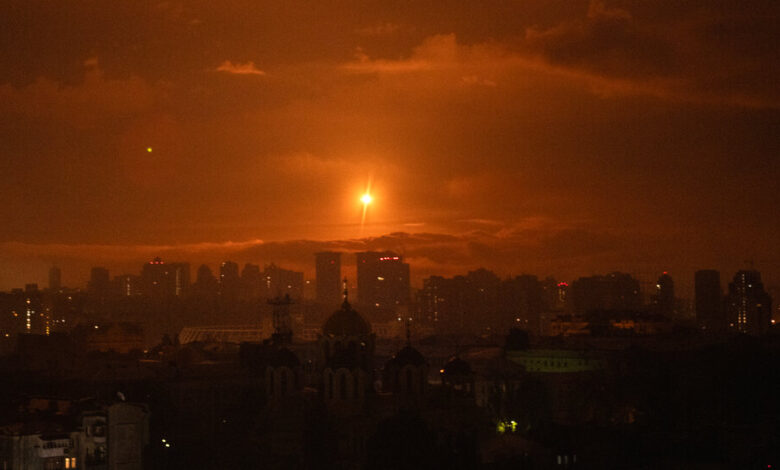Ukraine says it has shot down most of Russia’s missiles and drones

Ukraine on Wednesday said it used an arsenal of anti-aircraft missiles recently replenished by the United States and other allies to shoot down 29 of the 30 missiles and exploding drones that Russia fired at the country. in an overnight attack.
This is one of Ukraine’s better interception rates so far in the war and underlines the impact of having new supplies of Western weapons to bolster an already troubled war effort in recent months.
In Kiev, authorities said they shot down an entire barrage of missiles and exploded drones aimed at the capital as they approached or flew above the city. The aerial firefight, between mostly Western-supplied air defense systems and incoming Russian missiles, took place over the city shortly before 3 a.m.
Earlier this year, Ukraine’s anti-aircraft ammunition supplies were dangerously depleted. Commanders at some batteries said their missiles were being rationed, allowing Russian missiles to fly straight in without hindrance. President Volodymyr Zelensky has repeatedly called for additional American-made Patriot air defense systems.
Zelensky reiterated the request Wednesday when rockets or debris fell on an apartment complex in Kryvyi Rih, central Ukraine, killing eight people and injuring 21 others. These missiles were fired after the first round early Wednesday morning.
The Biden administration has decided to provide Ukraine with an additional Patriot system, including launchers, missile depots and powerful radar antennas to search for targets. Other countries are also considering transferring Patriot launchers to Ukraine. German Defense Minister Boris Pistorius said that Germany has organized a donation of 100 missiles from its warehouses and those of Denmark, the Netherlands and Norway, of which 32 have been delivered so far.
As the attack unfolded Wednesday, lightning flashed across the sky and explosions were heard. Authorities said one civilian was injured by falling debris.
“The enemy has launched another missile attack on the capital,” Kyiv military officials said in a post on the Telegram social network. As is typical of recent Russian attacks, the attack combined a variety of weapons, including drones and cruise missiles. This tactic is aimed at overloading Ukraine’s air defense forces.
The cruise missiles, launched from bombers flying in Russian airspace, were timed to arrive in Kyiv at the same time as a series of Iranian-designed Shahed exploding drones.
During the overall attack, according to the Ukrainian Air Force, Russia also fired three ballistic missiles, one ground-launched Iskander medium-range ballistic missile and two air-launched Kinzhal, or Dagger, missiles. launched from an airplane and flying at supersonic speeds. speed. Ukrainian and Western officials say the Patriot interceptor system is the only defense against Dagger missiles.
Ukraine shot down five of six missiles and all 24 Shahed drones, the air force said in a statement that could not be independently confirmed.
Ukraine’s rate of interception of drones and missiles fell in the first months of this year compared with a year earlier, as the country’s anti-aircraft ammunition ran low and Russia adjusted its tactics to evade the systems. existing defenses.
The average drone shoot-down rate in the 12 months to April was about 80%, data from the Ukrainian Air Force shows. Data shows that missile interception rates have dropped in some months this year to below 50%.
In addition to strengthening air defenses, the arrival of American weapons has helped stabilize precarious positions along the front line and slow down the Russian offensive in the northeastern region of Kharkiv. Troops complaining about ammunition shortages opened fire again.
Conference approved additional aid in AprilAfter months of delay, the US military rushed to Ukraine to deliver artillery ammunition and weapons such as Stinger short-range air defense missiles and Javelin anti-tank missiles, adding to Ukraine’s arsenal.
One effect, soldiers serving in artillery positions said, was the lifting of rationing regulations that prohibited firing on small groups of Russian soldiers, since consuming their limited ammunition was unworthy. Now, Ukrainian forces can provide fire support to front-line soldiers facing such attacks by small units.
European countries also increased the supply of anti-aircraft missiles to Ukraine. Valeriy Romanenko, a senior researcher at the National Aviation University of Ukraine, said that with more missiles for short-, medium- and long-range systems, Ukraine will likely increase its interception rate in Russian missile attacks.
In addition to the US Patriot long-range air defense systems and the French and Italian long-range SAMP/T systems, Ukraine also operates a series of Western short- and medium-range air defense systems. These include the NASAMS launchers, an American-Norwegian design; US Hawk missiles; and a recently developed German system, IRIS-T.
Mr. Romanenko said Wednesday’s strike showed good results in shooting down cruise missiles, but too few missiles were fired to determine whether Ukraine’s air defense system was fully restored after shortage or not. He said this volley could be a Russian probe attack aimed at destroying the location of Ukrainian air defense positions. The real test will come with a larger attack.
In neighboring Poland, the military said it had dispatched jets to protect airspace while Russian missiles were flying over Ukraine.
In Kiev on Wednesday, falling debris injured the leg of a civilian, the city’s military administrator, Ruslan Kravchenko, said in another Telegram post. Falling rocket debris also caused two fires.
Debris from the interceptions – sometimes small, silvery pieces of metal and sometimes heavy rocket engines – fell on Kyiv after such engagements, often causing injuries. The debris was from both interceptors and incoming Russian missiles.
In recent attacks, Russia has targeted power plants and so far this month, about half of Ukraine’s generating capacity has been destroyed. As a result, the government ordered rotating power cuts nationwide.
Natalia Novosolova Report contributions.




